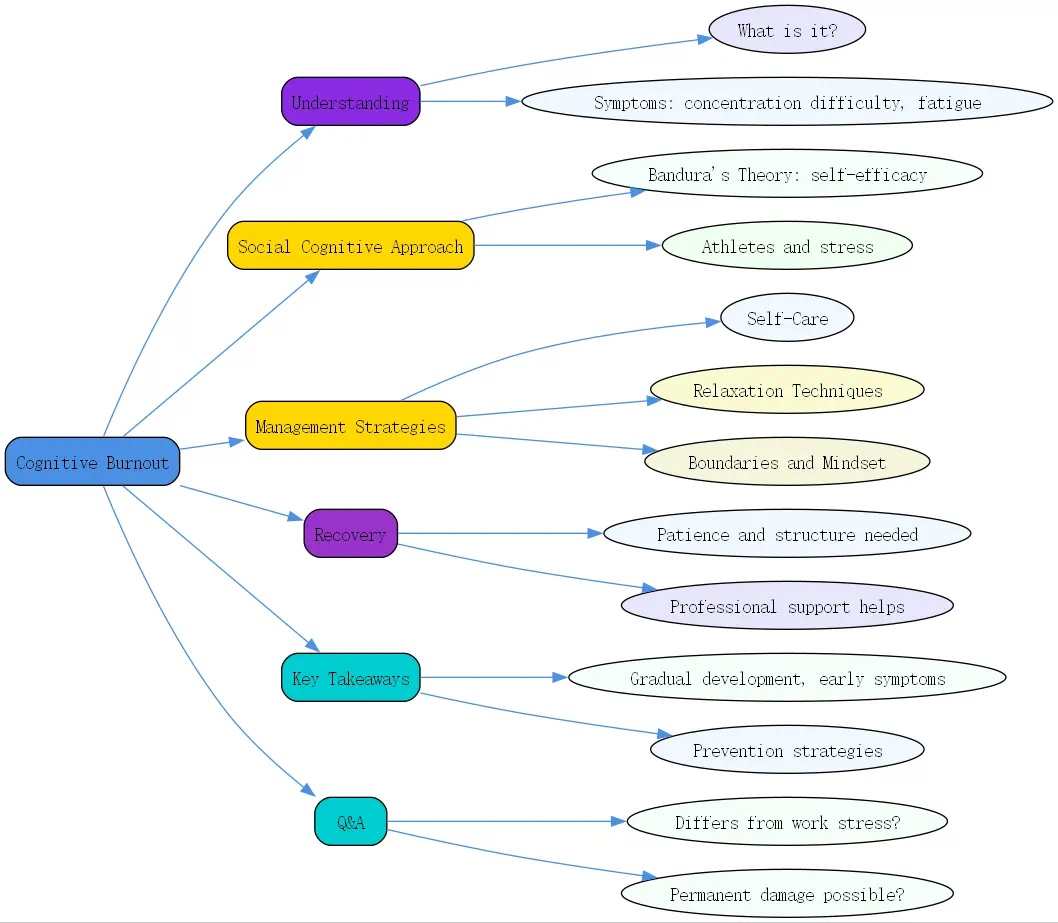Understanding Cognitive Burnout

What is Cognitive Burnout?
Cognitive burnout represents a state of mental exhaustion resulting from prolonged stress and overexertion of your cognitive resources. Unlike ordinary fatigue that resolves with rest, cognitive burnout is a persistent condition that significantly impairs your mental performance and overall well-being. This condition develops gradually as chronic stress depletes your mental reserves, leaving you feeling emotionally drained and intellectually depleted.
The relationship between stress and cognitive burnout is cyclical. Initially, stress may actually enhance performance by increasing alertness and focus. However, when stress becomes chronic and overwhelming, it triggers a cascade of neurobiological changes that eventually lead to cognitive burnout. The brain’s constant state of hyperarousal depletes neurotransmitters like dopamine and serotonin, crucial for cognitive functions and mood regulation.
Burnout Cognitive Symptoms
Burnout cognitive impairment manifests through various symptoms that directly affect your mental capabilities. Chief among these is a noticeable decline in memory function. You might struggle to recall important information, forget appointments, or have difficulty remembering details that were once easily accessible. This memory impairment often coincides with diminished focus and attention, making it challenging to concentrate on tasks that previously seemed straightforward.
Difficulty concentrating represents another hallmark of burnout cognitive symptoms. You may find yourself unable to maintain attention on a single task, with your mind constantly wandering or being easily distracted by minor stimuli. This fragmented attention makes completing complex tasks particularly challenging and time-consuming.
Mental fatigue serves as perhaps the most pervasive burnout cognitive symptom. This isn’t the typical tiredness that follows a busy day—it’s a profound and persistent exhaustion that doesn’t resolve with rest. You might experience a sensation of mental fogginess, reduced processing speed, and difficulty engaging in cognitive tasks that demand precision and clarity.
The Stress Scenario: High-Pressure Jobs and Cognitive Overload
High-pressure professional environments often serve as breeding grounds for cognitive burnout. The constant demands of tight deadlines, extended working hours, and high-stakes situations create a perfect storm for cognitive overload. Consider healthcare professionals who make life-or-death decisions daily, financial analysts managing millions in investments, or air traffic controllers maintaining constant vigilance—these roles exemplify environments where cognitive demands rarely diminish.
The modern workplace has intensified these pressures through constant connectivity and the blurring of work-life boundaries. Many professionals remain tethered to their responsibilities through smartphones and laptops, unable to fully disconnect and recover. This perpetual “”on-call”” status prevents the brain from entering crucial recovery periods, accelerating the path toward cognitive burnout.
The tipping point from stress to cognitive burnout often occurs subtly. Initially, you might notice occasional lapses in concentration or unusual forgetfulness. As burnout progresses, these cognitive symptoms become more frequent and pronounced, ultimately interfering with your ability to perform professionally and function effectively in daily life.
The Social Cognitive Approach to Burnout
Bandura’s Social Cognitive Theory and Burnout
Bandura’s social cognitive theory and burnout share a significant conceptual relationship that helps explain why some individuals develop burnout while others remain resilient under similar circumstances. Albert Bandura’s theory emphasizes the importance of self-efficacy—your belief in your ability to succeed in specific situations. When confronting chronic stress, individuals with high self-efficacy often demonstrate greater resilience, viewing challenges as opportunities rather than threats.
In the context of burnout, self-efficacy plays a crucial role in how you perceive and respond to workplace demands. Those with lower self-efficacy may experience heightened stress responses when facing difficult tasks, as they doubt their capability to handle challenges effectively. This doubt initiates a negative spiral: stress impairs performance, diminished performance further reduces self-efficacy, and the cycle continues toward burnout.
Observational learning, another key component of Bandura’s theory, explains how organizational cultures can either promote or prevent burnout. When team members observe colleagues working excessive hours or prioritizing work over well-being, they may adopt similar patterns through social modeling. Conversely, environments where leaders model healthy boundaries and stress management practices can foster protective behaviors among team members.
A Social Cognitive Approach to Burnout in Elite Athletes
A social cognitive approach to burnout in elite athletes reveals unique dynamics within high-performance sports. These athletes operate in environments where performance expectations are extraordinarily high, public scrutiny is intense, and the margin for error is minimal. The social cognitive perspective helps explain why elite athletes—despite their physical conditioning and mental training—remain vulnerable to burnout.
Perfectionism plays a central role in athlete burnout. Many elite athletes internalize extremely high standards, viewing anything less than perfect performance as failure. This perfectionistic mindset creates a psychological environment where the athlete never feels satisfied with their accomplishments, driving them to train harder and longer despite diminishing returns. Through the lens of social cognitive theory, this perfectionism represents maladaptive thought patterns that mediate the relationship between environmental stressors and burnout outcomes.
Social comparison further complicates the picture for elite athletes. In competitive sports, athletes constantly evaluate their performance against competitors, teammates, and their own previous achievements. This ongoing comparison can erode self-efficacy when athletes perceive themselves as falling short, creating psychological vulnerability to burnout. When managing social anxiety, a cognitive behavioral therapy approach client workbook can provide athletes with strategies to address these comparison-related anxieties.
Real-World Examples of Stress Affecting Performance
Across diverse professions, cognitive burnout manifests in remarkably similar patterns. Consider these real-world examples:
Healthcare professionals frequently experience cognitive burnout due to extended shifts and high-stakes decision-making. A nurse working consecutive 12-hour shifts might administer incorrect medication dosages not from lack of knowledge, but from stress-induced attention lapses and mental fatigue.
Educators demonstrate burnout through diminished classroom engagement. A once-passionate teacher may find themselves delivering lessons mechanically, lacking the creative energy to develop engaging materials due to chronic administrative stress and emotional exhaustion from managing classroom dynamics.
For financial professionals, burnout can manifest as analysis paralysis. A financial analyst might procrastinate on important investment decisions, overwhelmed by perfectionism and fear of making errors under pressure. This hesitation often leads to missed opportunities and decreased performance, further fueling stress.
Tech professionals frequently experience burnout through social withdrawal. A software engineer might begin avoiding team meetings and collaborative sessions, falling behind on project timelines as cognitive exhaustion makes social interactions feel overwhelming and mentally taxing.
The common thread across these examples is how burnout cognitive impairment impacts essential job functions, creating a self-reinforcing cycle where diminished performance increases stress, further exacerbating burnout symptoms.
Stress Management Strategies to Combat Cognitive Burnout
Self-Care Magic: Reclaiming Your Well-being
Addressing cognitive burnout begins with prioritizing self-care—not as a luxury, but as an essential component of cognitive maintenance. In our achievement-oriented culture, many professionals mistakenly view self-care as indulgence rather than necessity. However, research consistently demonstrates that deliberate self-care practices serve as powerful preventative measures against cognitive burnout.
Mindful breathing represents one of the most accessible self-care practices. Even during the busiest workdays, you can practice brief mindfulness exercises by focusing on your breath for just 2-3 minutes. This brief pause helps activate your parasympathetic nervous system, counteracting the stress response and giving your cognitive systems a moment to reset.

Physical movement—whether structured exercise or simply short walking breaks—provides another crucial self-care element. Exercise increases blood flow to the brain, promotes the release of mood-enhancing neurochemicals, and helps regulate stress hormones that contribute to cognitive burnout. Even modest physical activity, such as a 10-minute walk during lunch, delivers measurable cognitive benefits.
Sleep quality deserves special attention in any cognitive burnout prevention strategy. During sleep, your brain undergoes essential maintenance processes, clearing metabolic waste and consolidating memories. Chronic sleep deprivation accelerates cognitive burnout by preventing these restorative functions. BrainTalking research indicates that prioritizing sleep hygiene—maintaining consistent sleep schedules and creating optimal sleeping environments—significantly improves cognitive resilience against burnout.
Relaxation Techniques: Calming the Inner Turmoil
Structured relaxation techniques offer powerful tools for managing the physiological aspects of stress that contribute to cognitive burnout. These approaches directly address the body’s stress response, helping regulate nervous system activation and restore cognitive equilibrium.
Meditation practice, even in brief sessions, trains your attention and builds neural pathways that support cognitive control. Research from BrainTalking shows that regular meditators demonstrate greater resistance to cognitive burnout, likely due to enhanced connectivity between brain regions involved in attention regulation and emotional processing.
Progressive muscle relaxation (PMR) provides another effective technique for burnout prevention. This practice involves systematically tensing and releasing muscle groups throughout the body, promoting physical relaxation that signals safety to your nervous system. As physical tension diminishes, cognitive systems receive fewer stress signals, allowing mental resources to replenish.
For professionals with time constraints, micro-relaxation practices offer accessible alternatives. These brief interventions—such as 60-second breathing exercises or 3-minute guided visualizations—can be incorporated throughout the workday, preventing stress accumulation before it reaches burnout levels. When addressing social anxiety, a cognitive behavioral therapy approach client workbook can provide structured exercises to incorporate these techniques effectively.
Building Your Fortress: Establishing Boundaries and Mindset Makeover
Boundary-setting represents a critical skill for preventing cognitive burnout in demanding environments. Many professionals, particularly those in helping professions or leadership roles, struggle with establishing and maintaining clear boundaries around their time, energy, and accessibility. This boundary diffusion creates vulnerability to burnout by preventing necessary cognitive recovery periods.
Practical boundary-setting strategies include designating specific times for email checking rather than remaining constantly responsive, learning to say “”no”” to additional responsibilities when already at capacity, and creating physical separation between work and personal environments when possible. These boundaries create psychological safety zones where cognitive recovery can occur.

Mindset transformation provides another powerful protection against burnout. Through cognitive reframing, you can shift how you perceive workplace challenges—viewing them as opportunities for growth rather than threats to your competence. This perspective shift activates different neurobiological responses, replacing threat-based stress reactions with challenge-oriented responses that preserve cognitive resources.
Cultivating realistic optimism—acknowledging difficulties while maintaining confidence in your ability to navigate them—creates psychological resilience against burnout. This balanced perspective prevents both denial of genuine challenges and catastrophic thinking that amplifies stress responses and accelerates cognitive depletion.
Organization as a Weapon: Achieving Productivity and Efficiency
Environmental and workflow organization serves as a powerful preventative measure against cognitive burnout. Disorganized physical and digital environments create cognitive load—requiring mental resources to filter irrelevant stimuli and locate needed information. This unnecessary cognitive taxation depletes the same resources needed for focused work, accelerating burnout progression.
Creating organized workspaces—both physical and digital—reduces this cognitive burden. Simple practices like maintaining clear desktop surfaces, implementing consistent file organization systems, and minimizing visual clutter preserve cognitive resources for essential tasks. These environmental adjustments reduce the mental effort required for everyday functions, creating cognitive savings that build resilience against burnout.
Task management strategies further protect against cognitive burnout by preventing overwhelm. Breaking large projects into smaller, manageable components prevents the paralysis that often accompanies facing complex challenges. Similarly, batching similar tasks—grouping emails, phone calls, or creative work—reduces the cognitive cost of context switching, preserving mental energy.
Priority-setting frameworks help professionals focus their cognitive resources on genuinely important tasks rather than spreading attention across every demand. Techniques like the Eisenhower Matrix (categorizing tasks by importance and urgency) provide structured approaches to decision-making that prevent the cognitive drain of continually reassessing priorities.
The Cognitive Burnout Recovery Journey
Recovering from cognitive burnout requires patience and a structured approach. The brain needs time to rebuild depleted resources and establish healthier patterns. Start with addressing the fundamental basics: ensure adequate sleep quality, implement nutritional support for brain health, and gradually reintroduce moderate physical activity.
Professional support plays a crucial role in burnout recovery. Therapists specializing in cognitive behavioral approaches can help identify and modify the thought patterns perpetuating burnout. When struggling with social dimensions of recovery, a cognitive behavioral therapy approach client workbook provides structured exercises to rebuild social confidence and engagement.

Remember that recovery isn’t linear—you’ll experience both progress and setbacks. Small improvements represent significant victories when recovering from cognitive burnout. BrainTalking experts emphasize that sustainable recovery focuses not just on symptom reduction but on building a new relationship with work, stress, and self-care that prevents future burnout episodes.
Key Takeaways
- Cognitive burnout develops gradually, with early symptoms including memory issues, difficulty concentrating, and persistent mental fatigue.
- Bandura’s social cognitive theory provides a framework for understanding burnout through concepts like self-efficacy and observational learning.
- Elite athletes face unique burnout risks due to perfectionism and constant social comparison.
- Effective prevention strategies include structured self-care, relaxation techniques, boundary-setting, and environmental organization.
- Recovery from cognitive burnout requires patience, professional support, and fundamental lifestyle adjustments.
Q&A: Common Questions About Cognitive Burnout
How does cognitive burnout differ from typical work stress?
Cognitive burnout represents a chronic condition resulting from prolonged, unmanaged stress rather than temporary pressure. While occasional stress typically resolves with rest and may even enhance performance, burnout involves persistent symptoms that don’t improve with normal recovery periods. The distinguishing features include emotional exhaustion, cynicism or detachment toward work, and reduced professional efficacy. From a neurobiological perspective, burnout involves dysregulation of stress response systems and depletion of neurotransmitters essential for cognitive function, creating more profound and persistent cognitive impairments than typical work stress.




